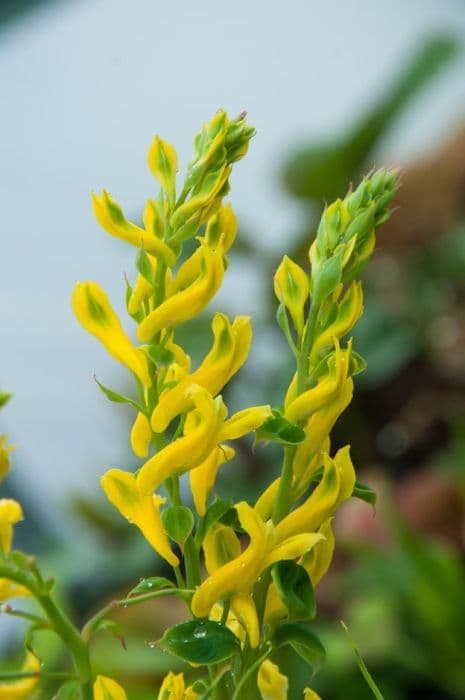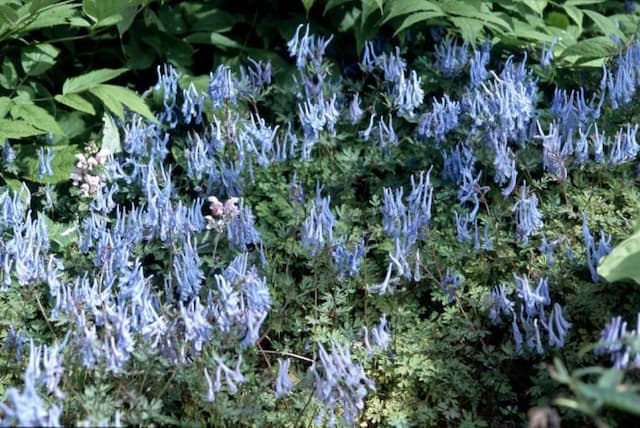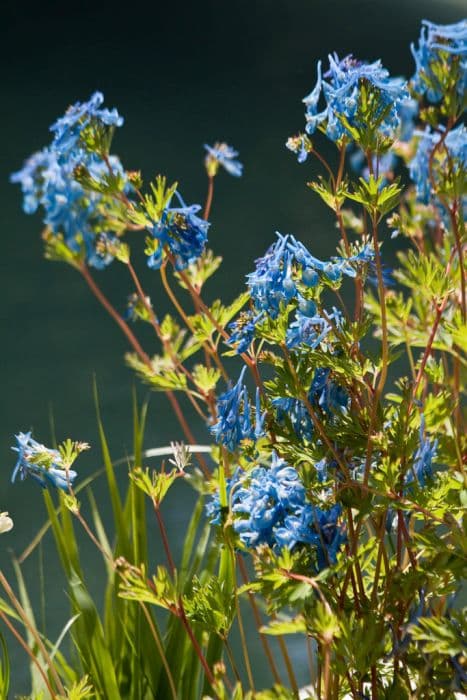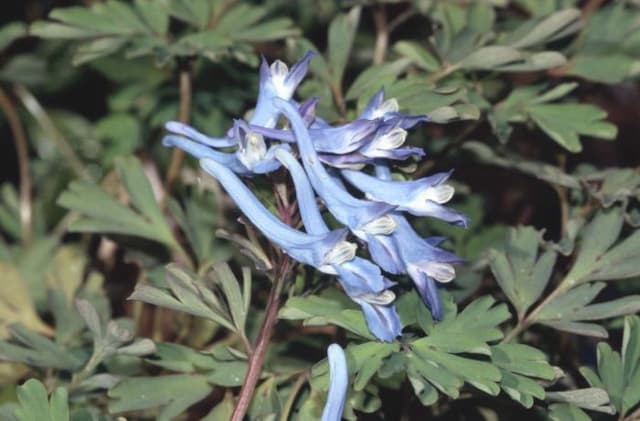Dutchman's Breeches Dicentra cucullaria

ABOUT
Commonly known as Dutchman's breeches, this charming perennial boasts a unique and noticeable flower shape that resembles a pair of white pants hung upside down, complete with a small yellow spot at the base of each "leg" that represents the pant's waistband. The flowers are borne in a raceme, gracefully arching above the foliage. The plant's leaves are also quite distinctive, being finely dissected, which gives them a feathery appearance. They are usually a bright green color that provides an attractive backdrop to the whimsical flowers. Overall, the delicate flowers and fern-like foliage of Dutchman's breeches create a whimsical and airy impression in the landscape where they thrive in the cooler seasons of the year.
About this plant
 Names
NamesFamily
Papaveraceae.
Synonyms
Dutchman's Breeches, Dutchman's Britches, White Hearts, Eardrops, Soldier's Cap.
Common names
Dielytra cucullaria, Fumaria cucullaria, Bicuculla cucullaria.
 Toxicity
ToxicityTo humans
Dutchman's breeches is considered toxic due to the presence of alkaloids, including isoquinoline, which can be harmful if ingested. The symptoms of poisoning may include tremors, nausea, vomiting, diarrhea, and in severe cases, respiratory distress. It is important for anyone who has ingested Dutchman's breeches to seek medical attention for proper management and supportive care.
To pets
Dutchman's breeches is toxic to pets. Ingesting this plant can result in poisoning, producing symptoms such as drooling, vomiting, diarrhea, seizures, and potentially, respiratory failure. Pet owners should ensure that their animals do not have access to Dutchman's breeches and should consult a veterinarian immediately if they suspect their pet has consumed any part of the plant.
 Characteristics
CharacteristicsLife cycle
Perennials
Foliage type
Deciduous
Color of leaves
Green
Flower color
White
Height
6-12 inches (15-30 cm)
Spread
6-12 inches (15-30 cm)
Plant type
Herb
Hardiness zones
3
Native area
North America
Benefits
 General Benefits
General Benefits- Aesthetic appeal - Dicentra cucullaria, commonly known as Dutchman's breeches, adds visual interest to gardens with its unique, heart-shaped flowers and attractive foliage.
- Spring interest - It blooms in early to mid-spring, providing early-season color when many other plants are just emerging.
- Native species conservation - As a native North American wildflower, cultivating Dutchman's breeches can help support local ecosystems and biodiversity.
- Attracts pollinators - The flowers attract early spring pollinators like bumblebees, which are necessary for the health of many ecological systems.
- Easy to grow - Dutchman's breeches can grow well in woodland settings and shady areas, making it an easy plant to cultivate in suitable conditions.
- Low maintenance - Once established, it is relatively low maintenance, requiring little care beyond ensuring the soil is kept moist.
- Naturalizing - It can naturalize over time, spreading to form larger clumps and creating a charming, naturalized look in a garden setting.
- Deer resistance - The plant is generally resistant to deer, which makes it an excellent choice for gardens in rural or suburban areas with a high deer population.
- Companion planting - Works well in a shade garden alongside other spring-blooming perennials such as trilliums and bleeding hearts.
 Medical Properties
Medical Properties- This plant is not used for medical purposes.
 Air-purifying Qualities
Air-purifying QualitiesThis plant is not specifically known for air purifying qualities.
 Other Uses
Other Uses- Dicentra cucullaria, commonly known as Dutchman's breeches, is sometimes used in native gardens for its unique aesthetic appeal as the flowers resemble pairs of white pants or breeches.
- The plant is often integrated into shade gardens, as it thrives in shaded areas, providing a delicate, fern-like foliage contrast to other shade-loving plants.
- Dutchman's breeches can serve as a spring nectar source for early-emerging insects, especially native bees, that are adapted to feed on the complex flower shape.
- It is occasionally used as a teaching tool in botany and horticulture to illustrate the concept of 'spring ephemeral' plants which have a short growth cycle in the spring and then die back.
- Some ecological landscapers utilize Dutchman's breeches in restoration projects to help stabilize soil and prevent erosion in woodland settings due to its network of roots.
- In folklore, this plant has been referenced as an inspiration for creative writing and art, due to its unique flower shape and early spring appearance.
- As a part of butterfly gardens, Dutchman's breeches can attract certain species of butterflies that are able to access the nectar, adding to biodiversity.
- In photography, particularly macro and close-up genres, the intricate flowers of Dutchman's breeches are popular subjects due to their distinctive shape and appearance.
- This plant is sometimes used in cut flower arrangements, for those seeking a wildflower or naturalistic aesthetic, although its delicate structure may not lend to longevity.
- Cultural significance is attributed to Dutchman's breeches in certain regions where it might be used symbolically during festivals to herald the arrival of spring.
Interesting Facts
 Feng Shui
Feng ShuiThe Dutchman's breeches is not used in Feng Shui practice.
 Zodiac Sign Compitability
Zodiac Sign CompitabilityThe Dutchman's breeches is not used in astrology practice.
 Plant Symbolism
Plant Symbolism- Love and Romance: Dicentra cucullaria, commonly known as Dutchman's Breeches, often symbolizes feelings of love due to its heart-shaped flowers, reminiscent of the iconic symbol for love and romance.
- Grace and Delicacy: The plant’s dainty and distinctive bloom shape reflects a sense of grace and delicacy, symbolizing a gentle nature and an appreciation for the subtle beauty.
- Affection: Given as a gift, Dutchman's Breeches can represent a token of affection, especially in the Victorian language of flowers.
- Attachment: The unique way the flowers cling to the stem has been said to symbolize deep attachment, whether familial, platonic, or romantic.
- Secret Bond: In some traditions, the hidden appearance of the flowers, reminiscent of pantaloons, can signify a secret bond between two people or a hidden message.
 Water
WaterThe Dutchman's Breeches should be watered thoroughly, allowing the soil to become moist but not waterlogged. During the growing season, water the plant about once a week or when the top inch of soil feels dry to the touch. These plants prefer a steady moisture level, so adjust your watering frequency based on weather conditions—more frequent watering during hot, dry spells and less during rainy periods. A general guideline is to provide around 1 gallon of water per week, but this may vary with environmental factors.
 Light
LightDutchman's Breeches thrives best in partial shade to full shade. The ideal spot for this plant would be under the canopy of larger trees or shrubs, where it can receive dappled sunlight. Avoid placing it in direct, harsh sunlight, as it prefers the cooler, shadier spots similar to its natural woodland habitat.
 Temperature
TemperatureDutchman's Breeches performs best in temperate conditions, with ideal growing temperatures ranging between 50-75°F. It can tolerate minimum temperatures down to around 28°F and maximum temperatures up to about 80°F; however, extremes beyond this range can be detrimental to the plant. Maintaining a cool to moderate temperature will ensure the health and longevity of the Dutchman's Breeches.
 Pruning
PruningPrune Dutchman's Breeches to remove dead or yellowing leaves and spent flower stems to maintain the plant's health and appearance. Pruning is best done after the plant has finished blooming, typically in late spring or early summer, which allows the plant to focus its energy on root and foliage development.
 Cleaning
CleaningAs needed
 Soil
SoilDutchman's Breeches thrive in organic-rich, well-draining soil with a pH between 6.0 and 7.5. A soil mix ideal for this plant would be equal parts of loamy garden soil, leaf mold or compost, and coarse sand to facilitate drainage.
 Repotting
RepottingDutchman's Breeches does not require frequent repotting; it should be repotted only when it outgrows its container, typically every 2-3 years.
 Humidity & Misting
Humidity & MistingDutchman's Breeches prefers moderate humidity levels but is adaptable to average household humidity. Aim for a humidity level of between 40-60%.
 Suitable locations
Suitable locationsIndoor
Ensure indirect light, cool temps, and moist, rich soil.
Outdoor
Plant in dappled shade with moist, humus-rich soil.
Hardiness zone
3-9 USDA
 Life cycle
Life cycleDutchman's breeches (Dicentra cucullaria) begin their life as seeds, typically dispersed in the wild by ants in a process known as myrmecochory. Upon finding a suitable and cool, moist, shaded habitat, the seeds germinate in the spring to develop into small seedlings. These seedlings grow into clump-forming perennial plants, which possess a bulb-like structure called a corm that stores nutrients for winter dormancy and regrowth. The plant produces distinct heart-shaped foliage and white, pantaloon-shaped flowers suspended on leafless stalks, which bloom in early spring. After pollination, primarily by queen bumblebees, the flowers develop into elongated capsules containing the seeds that complete the reproductive cycle. As warmer summer temperatures set in, Dutchman's breeches become dormant, with the foliage dying back and the plant relying on its corm to survive the winter until the next growing season.
 Propogation
PropogationPropogation time
Spring
The most popular method of propagating Dutchman's breeches, scientifically known as Dicentra cucullaria, is by dividing the tubers. The ideal time to divide and propagate this woodland perennial is in the fall, after the plant has died back. Carefully dig up the tubers while trying to minimize root damage. Each division should have at least one growth bud to ensure successful regrowth. Replant the divisions immediately, spacing them about 6 to 12 inches (15 to 30 cm) apart, and at the same depth they were growing previously. Water the newly planted divisions to settle the soil around the roots and help reduce transplant shock. This method allows for the relatively quick establishment of new plants, which will mature and flower in a couple of seasons.









